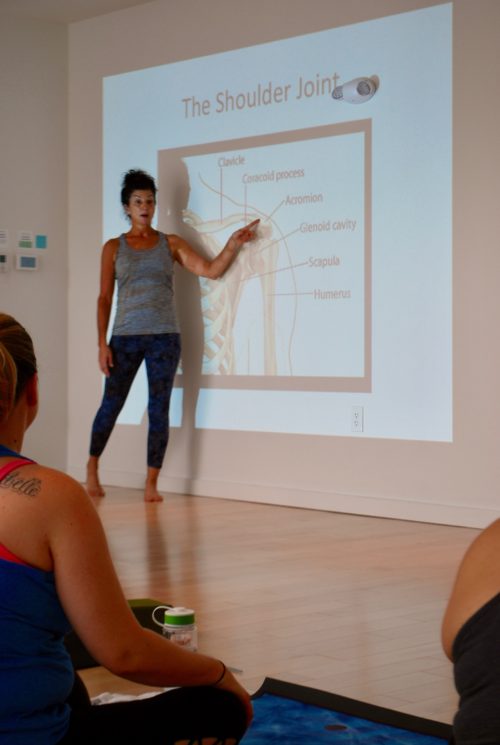
When we go to yoga class, we are met with resistance in both the body and mind. When we look at the points of resistance in the body, they offer mirror the actions we most regularly take in our daily lives. So, if we have a job where we’re reaching overhead a great deal, performing the action of shoulder flexion, muscles like the anterior deltoid will get very developed while the muscles of shoulder extension will weaken. So poses like Warrior 1 might work but poses like Up Dog might be more challenging.
Most of us spend a great deal of time in a “shoulder forward” position so the muscles that internally rotate our shoulders get overused while muscles that externally rotate, or open, the shoulders, are not used as much. In class, when we ask students to take an arm bind, either by interlacing the fingers behind the back or by taking a half bind in a pose like Extended Side Angle to Bound Side Angle, it requires that they have a good amount of flexibility in the muscles that are responsible for internal rotation. These are muscles like the teres major and the subscapularis. But because we spend so much time hunching, it’s hard.
So, in a pose like Extended Side Angle, if we take the long arm that is in the air and “shorten the lever” by having the student take their “hand to their hip” we can then cue them to “open the shoulder” and it will have a greater effect. This is because the lever of the arm is now shorter and they can “get to the joint” where the action is, much easier. Some of this just has to do with their point of focus; if they’re focused on their hand and getting it behind their back, it’s very hard to do that with tight internal rotators. If we, as teachers, focus our cues to the action point, the shoulder joint, as well as ask them to shoulder the lever, they’ll have a much better result.
I talked about this in my Facebook Live today which is in my anatomy workgroup on Facebook. You can join the group and see the video just by clicking here.Â
Tight muscles can also be helped via myofascial release or ball rolling. I’ll be teaching these techniques as part of my Urban Wellness Weekend in January here in Boston (Cambridge). This two day conference is filled with many experiences to round out your learning on how to live healthy. There’s yoga, presentations by expert speakers in neuroscience and medicine, a speaker panel to share inspiring stories from their lives and careers and healthy food, vendor demos and more.
Spots are going fast for this event so don’t miss out. Plus there is early bird pricing so sign up now.
Here’s your invite:
The Bare Bones Yoga Urban Wellness Weekend
Also, if you’re looking for more information on effective cues, watch my quick webinar here.Â
Thanks for reading and please leave a comment below. What do you think of this idea presented here?
